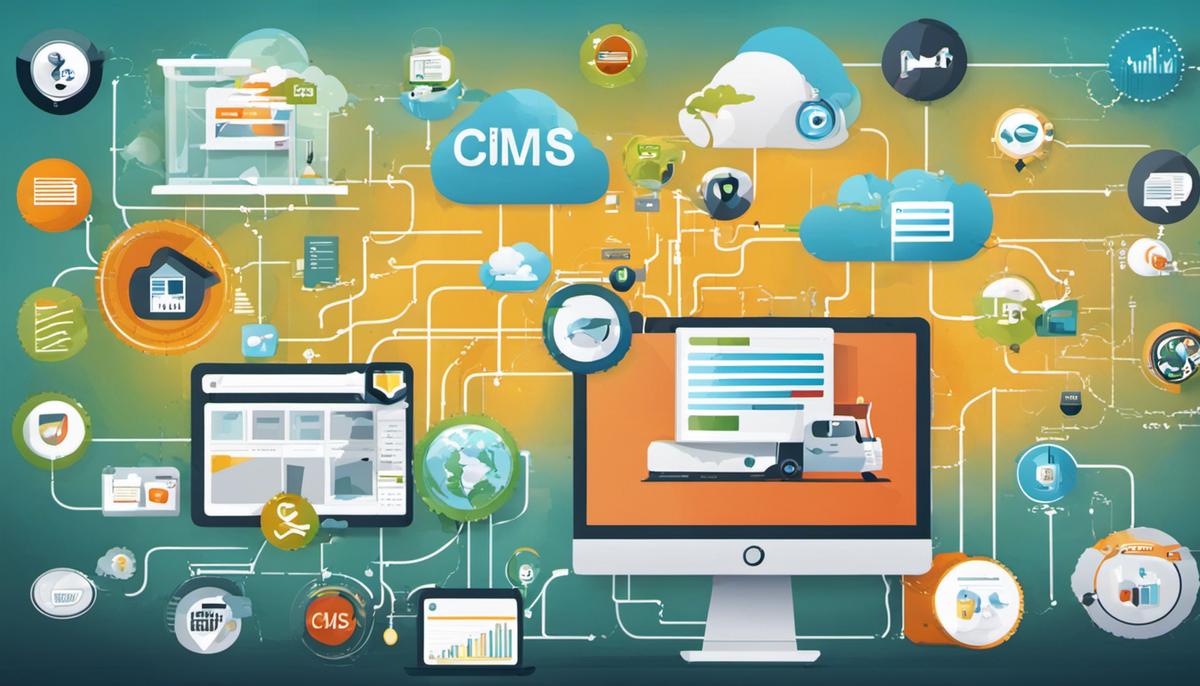In today’s technologically driven world, businesses must continually adapt to maintain a compelling online presence. One such adaptation often involves migrating from one Content Management System (CMS) to another. This process, known as CMS migration, can bring about improved functionality, user experience, and efficiency. But, to harness these benefits, one must understand what drives CMS relocation and how to navigate it effectively. This comprehension includes selecting the ideal CMS platform, planning for data migration, and executing the process with minimal interruptions to the business operations. Post-migration, it’s crucial to have strategies in place to capitalize on the new platform.
Understanding CMS Migration
The ABCs of CMS Migration: The What, How, and Why
Few aspects of digital management can inject as much trepidation into those of technophile tendencies as CMS (Content Management System) Migration. After all, isn’t it disturbing to even contemplate the potential disruption and disorder from transferring all of our precious digital assets from one platform to another? Definitely. But put the fears aside for a moment. CMS Migration is less a digital leap of faith and more a calculated move—a foundational element of an effective content strategy that’s essential in the digital age.
So, what exactly is CMS Migration? Essentially, it’s the process of moving data and content from one CMS platform to another. This can involve transferring entire websites, databases, email systems, and other digital assets. CMS Migration is not for the faint of heart or tech-averse. It requires comprehensive understanding of not just the initial and target CMS platforms, but also the intricacies of the constantly evolving digital landscape.
Why undertake a task so seemingly fraught with digital danger, you ask? The answers are multiple and compelling.
First and foremost, efficiency. With digital transformation being the buzzword du jour, businesses need to be agile, and an obsolete CMS will more often be an obstacle rather than a vehicle for business progress. A well-executed migration to a modern CMS will streamline operations, offer more comprehensive options for customization, and enhance overall user experience—without a doubt a significant boost to the operational objective of any organization.
Secondly, security. Older systems are typically more vulnerable to cyber threats due its outdated technology which hackers can confidently exploit. The latest CMS, armed with the newest defense protocols and regular updates, can significantly lower the potential risk of a cyber-attacks—making CMS migration not just a good to have feature, but a must-have shield in the war against cyber threats.
Accompanying the elimination of security vulnerabilities, the upgraded systems also allow the implementation of new capabilities. Want a system that supports AI apps? Need a platform that allows easy integration with third-party solutions? Looking for more responsive design options? The only effective answer to all these is a resounding yes to CMS migration.
And let’s not forget data management. This pivotal aspect of digital strategy is often overlooked. A more modern CMS promises better data management systems, thus supporting insightful analysis and informed decision-making.
Now that we know the what and the why, it’s quite clear that CMS Migration is critical. It might require a well-thought-out strategy, a detailed plan, and might not be as easy as flip-the-switch, but the benefits that accompany this tech modification are definitely worth the effort.
So, to those who break out in a cold sweat at the mere thought of CMS Migration, it is time to step out of the comfort zone of the status quo. Embrace the change. Because being technologically advanced isn’t just about staying updated, it’s about being prepared for the future.

Determining the Right CMS
Selecting the Most Apt CMS Platform for Migration
Delving deeper into CMS migration, there’s a crucial decision that businesses must make – the selection of the right Content Management System (CMS) to migrate to. It’s paramount to conduct a meticulous evaluation of potential CMS platforms. This process firmly stands on understanding your business goals, the unique needs of your audience, and the range of functionalities your operation requires. Here’s an analytic approach to aid technophiles in making an informed decision.
Start by Cataloging Specific Business Requirements
Precisely knowing what your business necessitates is the cornerstone of choosing an apt CMS platform. Do not be seduced by flashy features that don’t serve the primary needs of your organization. Instead, focus on the features that directly enhance operational efficiency and productivity. Whether it’s advanced user permissions, integrated SEO tools, or robust publishing workflows, every operational requirement must be itemized before starting the selection process.
Prioritize Scalability and Flexibility
Given today’s rapid tech advancements, opting for a scalable and flexible CMS can prevent you from constant redesigns and migrations. Always strategize for the future and pick a platform that accommodates growth and change. A rigid system might suffice for present needs but will tangle up business processes in the long haul, swamping your tech reliability and resource allocation.
Understand the Usability
Regardless of how functionally rich a CMS is, if your team cannot use it efficiently, it’s irrelevant. Evaluate the platform’s usability to ensure it aligns with your team’s skill level. The user interfaces should be intuitive and accessible. Instead of creating a steep learning curve, it should be conducive to simplifying tasks, hence, enhancing productivity.
Factor in the Associated Costs
Scrutinize the total cost of implementation, including license fees, charges for updates & maintenance, cost of hosting, and additional charges for plugins or modules. Having a comprehensive understanding of these costs aids in deciding whether the platform fits within the budgetary confines or whether it will drain resources in the long run.
Delve into Security Features
A CMS platform should offer state-of-the-art security features. Dig into whether it includes routine updates and patches to fix security vulnerabilities. It’s crucial that the platform provides reliable protection for your data to maintain both internal and customer trust.
Evaluate Support and Community
Last of all, delve into the platform’s community and support. Opt for a platform that provides robust support resources, including active community forums, detailed documentation, responsive customer service, and opportunities for further learning.
In conclusion, CMS migration is not about shifting from an outdated system to a new one; it’s about strategic evolution towards efficiency, security, and sustainability. Keep the ball in your court and choose a CMS platform that aligns with your business agenda, one that streamlines operations and fosters growth. Remember, technology is a problem solver – let’s keep it that way. As you embark on this digital journey, it’s essential to keep the focus on strategic alignment, keeping abreast of the tech game, and not being afraid to push boundaries. After all, advancements stop for no one.

Data Migration Planning
Planning for CMS Data Migration: Steps and Best Practices
Having established a firm comprehension of the intricacies of a CMS migration, this section is dedicated to the successful navigation of this typically intricate paradigm. Rather than perceiving it as a challenge, remold your perspective to view it as the next stepping stone to phenomenal digital growth! Here’s an incisive elaboration of the steps and best practices involved in planning for a CMS migration:
- Inventory and Audit Content:
Although it may seem straightforward, auditing and cataloging every bit of existing content is an indispensable starting point. This exhaustive inventory includes everything from articles, images, pdf files, metadata, user comments to related tags, and helps in identifying outdated, redundant, or irrelevant content to avoid unnecessary clutter post-migration.
- Mapping out Content:
Upon auditing, the next logical step is to map out a precise and detailed plan for where each piece of content will live in the new CMS. This process involves categorizing your content, determining how it aligns with the new CMS structure while ensuring no critical data is left behind.
- Conducting Thorough Backups:
To safeguard against any potential loss of data mid-migration, proper backups of all data, files, and databases are non-negotiable. Consider this a robust contingency plan, which could save hours of efforts and immense panic when things unexpectedly go south.
- Thorough Vendor Evaluation:
Choose a service provider painstakingly. A migration partner’s expertise, reliability, and assistance shouldn’t be compromised. Make sure they can offer comprehensive solutions including performance, speed, SEO support, data recovery, and most importantly, security during and after the migration.
- Testing the New System:
Post-migration, testing the new system thoroughly to ensure all data is accurately migrated should be a top priority. A number of factors to test include multipart forms, integrations with external software, mobile responsiveness, and general CMS functioning.
- Post-Migration SEO Analysis:
Following a CMS migration, SEO changes are inevitable. Take time to analyze and assess impacts on page rankings, redirects, and broken links. Remember, even slight alterations to site structure can influence SEO, so a meticulous post-migration breakdown is a must.
- Training the Team:
Lastly, migrate people, not just the content. Users unfamiliar with the new system can lead to mishaps and inefficiencies. Hence, comprehensive training sessions and transition assistance are vital for smooth adaptability and proper utilization of the new CMS features.
To sum up, the goal of your CMS migration strategy should be more than just surviving the transition. It should be about seizing an incredible opportunity to improve your digital prowess, streamline operations, and enhance output. Each migration is different, so adjust these steps as per the unique needs of your project. Remember, all great revolutions, including digital ones, commence with well-planned actions. Embrace the change, jump headfirst into data migration, enjoy its multitude of advantages, and let the technology do the rest.

Executing the Migration
Testing CMS migrations without disrupting existing operations is an art that exists at the intersection of technology and strategy. However, the trick lies in the application of technology, and addressing it head-on. Any hiccup can be disastrous, but with the following strategies, you’ll enjoy a smooth CMS migration process ensuring seamless and consistent operations.
An intriguing part of the migration involves leveraging a staging environment to avoid drastic effects on the live site. Creating a “playground” to test all the scenarios, functionalities, and UI/UX is an irreplaceable part of the migration and ensures any bugs are fixed before transitioning to the new environment. Thus, it eliminates the embarrassing conundrum of conduct turning into chaos.
Reduction of downtime is not just jargon, but one of the prime indicators of successful migrations. Scheduling the migration process during the ‘off-peak hours’, in other words, when the traffic on the website is at its lowest, is a rational and efficient action. This minimal disturbance window allows for a speedy migration and swifter rectification of unanticipated problems.
When it comes to data migration, one size doesn’t fit all. The sheer volume of data often looks overwhelming. But worry not, for the answer lies in prioritization. Rather than migrating content en masse, transition high-priority content first and subsequently, follow it up with the rest. It offers the double advantage of keeping track and maximizing the efficiency of data management.
Hand in hand with data migration is URL structuring. Redefining- or better, retaining- URL structure is pivotal in preventing loss of traffic and improving SEO rankings. Redirects should be well-planned and tested effectively to ensure a seamless user experience and pleasing Google bots.
Automation tools: the silver bullet. While a manual approach allows the greatest control, excessive command and control could lead to human errors. CMS migration tools provide the perfect antidote to the time-consuming, exhaustive manual migration procedure by maintaining accuracy and consistency. Vendors often offer such tools. Ensuring their reliability is a preliminary step towards a successful transition.
CMS training is a catalyst for operations. The migration is a naught if the team is unable to handle the new system. Hence, training staff before the actual switch is pivotal in ensuring continuity in operations post-migration. That’s where documentation comes in. A systematic, well-structured training document simplifies the transition and ensures the team is well-equipped to utilize new functionalities.
In conclusion, conducting CMS migration without disrupting existing operations isn’t an uphill battle if the right strategies are engaged. By harnessing the power of staging environments, prioritizing data migration, focusing on URL structure, using automation tools, and arranging for thorough training, you can secure a well-synchronized, efficient, and successful CMS migration. Therefore, a mix of robust strategies and technology is what’s needed while conducting CMS migrations.

Post-Migration Strategies
Stability and Growth: The Post-Migration Journey
Now that the complex process of CMS migration has been undertaken, the focus shifts to the equally crucial task of ensuring stability and driving growth in the post-migration phase. Without doubt, stability is the priority. However, the ultimate end game is growth. It’s like buying a new high-tech car; it’s not simply about maintaining the vehicle, but utilizing its features to maximize performance and enhance the driving experience.
Achieving Stability: Continual Monitoring and Optimization
Stability is more than just the absence of crashes or bugs; it encompasses consistent performance, security, and optimal functionality. To achieve this, continual monitoring and optimization of the new CMS is key. Quality assurance should be more than a phase; it should be a constant endeavor. Using advanced analytics tools, teams can detect performance anomalies and address them swiftly.
Also, it’s essential to keep the CMS updated. Pro-tip: newer versions often feature security patches, bug fixes, and improved functionality. Regular updates safeguard the CMS from emerging security vulnerabilities and ensure the system runs smoothly. From a technical standpoint, optimization of server resources and database should also be carried out to increase speed and enhance user experience.
Driving Growth: Analytics, Personalization, and Innovation
In a fast-paced digital landscape, monitoring the analytics continuously gives a detailed insight into user behavior which is key to driving growth. By understanding how users interact with the site, businesses can evolve their strategies to cater to changing consumer preferences.
Another step towards growth involves personalization. Recognize this: in today’s digital landscape, a one-size-fits-all approach doesn’t cut it anymore. The modern CMS solutions support personalization enabling businesses to deliver content tailored to the user’s preferences, thus boosting engagement.
Last but not least, innovation. Growth does not happen without it. Continually enhancing the capabilities of the CMS to meet growing business needs is a surefire route to growth. Whether it’s integrating advanced features or improving existing ones, innovation goes hand-in-hand with growth.
Reality Check: Challenges along the Way
It’s a given that with any powerful new tech, there’s an initial learning curve. The same is valid for a new CMS. Navigating its complex interface and understanding the functionality may require time and patience. To alleviate this challenge, access to support and documentation is critical. Online communities come handy here, offering peer-to-peer support, tutorials, and solutions to common problems.
Remember, change is a constant in the tech landscape. The new CMS might be perfect for the current needs, but it needs to evolve with time. Upgrades and improvements should be ongoing to keep up with changing tech trends.
No new technology is a magic bullet. But with continuous monitoring, optimization, and constant innovation, achieving stability and driving growth post-CMS migration is not a far-off dream. Embrace the journey, and reap the advantages the cutting-edge CMS brings to the digital table.

Grasping the various elements of CMS migration—choosing the suitable CMS, planning and scheduling the migration, executing it, and developing post-migration strategies—is invaluable in today’s dynamic digital age. These insights not only facilitate smoother migrations but also enable businesses to leverage the new platform effectively. Because in the end, the success of a CMS migration isn’t just about moving content from one system to another, but about how well the new system helps a company connect, communicate and grow in its digital journey.






